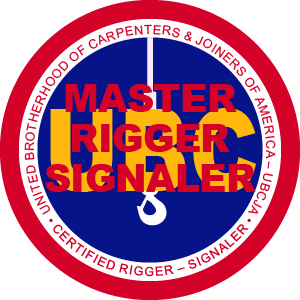


Certified Master Rigger and Signaler/Lift Director (CMRS/LD)
The CICC offers the CMRS/LD certification designation to those candidates who meet the ANSI Safety Requirements for Rigging Qualifications and Responsibilities in the Construction Industry, ASME B30 Standards on Cranes and Related Equipment, and OSHA 1926 Subpart CC – Cranes and Derricks in Construction.
Certification holders may state that they are Certified Master Riggers and Signalers/Lift Directors and may use the CMRS/LD designation to market their credentials on business cards, resumes, etc.
Additionally, each CMRS/LD receives a certificate and their credentials are posted on their wallet-sized verification card. The verification card has a Quick Response (QR) code that links to a database of certification and qualification records. The certificates and electronic records contain the name, date of expiration, and the unique membership ID number of every individual who has successfully completed the CMRS/LD written test.
The purpose of the CMRS/LD program is encompassed within the mission of the CICC. The purpose of credentialing individuals with the CMRS/LD designation is to instill confidence in the public, contractors, and the job site crew regarding the quality of the deliverables and the safety of the practices being employed.
In support of this mission, the CMRS/LD program:
- Develops, evaluates, updates, and administers different written examination forms to assess the knowledge and skills required to competently perform the job tasks of an advanced rigger, signaler, and lift director.
Click here to view the CMRS/LD Candidate Information Brochure.
Click here to view the CMRS/LD Exam Summary Report.
Eligibility Criteria
To become a CMRS/LD, a candidate must be a UBC member and must successfully complete a knowledge-based written examination. By passing the test, a candidate demonstrates competency in the knowledge and skills required to perform safely and effectively as a CMRS/LD.
Prerequisites
In order to qualify to sit for the CMRS/LD exam, a candidate must first have a current Certified Rigger and Signaler (CRS) or current Rigging Qualification.
What is the format of the CMRS/LD written examination?
Candidates are allotted four (4) hours to complete the CMRS/LD written examination. The content of the examination follows the plan (detailed below), which was derived from an in-depth practice analysis validation study that was completed in 2017.
The written examination has a total of 100 questions, which includes 20 experimental items throughout. These experimental items do not count for or against a candidate’s exam score and are included to collect information on questions that may be incorporated into future test forms.
| Dimension & Sub-Dimension | Number of Items on Exam |
|---|---|
| Rigging Procedures | |
| Hitch Configuration | 15 |
| Application | 30 |
| Rigging Safety | |
| Critical Hoist/Lift Plans | 16 |
| Site Awareness/Personnel Safety | 15 |
| Load Stability | 4 |
| TOTAL | 80 |
CMRS/LD Practice Analysis Report
Click here to view the CMRS/LD Practice Analysis Report
What does it take to pass the CMRS/LD written examination?
The pass point for the CMRS/LD written test is 500, based on a scaled scoring system. To allow for consistency and ease of interpretation, candidates’ scores are changed from their raw score (i.e., number correct) to a scaled score. Specifically, the raw scores are changed to a scale that ranges from 200 to 800, where 500 is the pass point. Therefore, regardless of how the test difficulty changes over time, the way the scores are interpreted will always remain the same. That is, a score from 500 to 800 will always indicate a passing score and a score from 200 to 499 will always indicate a failing score.
Is there a practical test?
No, there is no practical test for the CMRS/LD certification.
How can I prepare for the CMRS/LD written examination?
The following reference list provides suggested materials that could assist you in preparing for the CMRS/LD written examination. This is not an open book examination; candidates are not allowed to bring reference materials into the test administration site.
- UBC Rigging Training Manual
- Bob’s Rigging and Crane Handbook
- IPT Crane and Rigging Manual
- Construction Safety Rigging Manual of Ontario
- OSHA 1926 Construction Standards
- ANSI 2010
- ASME B30.20 – 2010 Below the Hook Rigging Devices
- ASME B30.26 – 2010 Rigging Hardware
- ASME B30.23 – 2011 Personnel Lifting Systems
- ASME B30.9 – 2009 Slings
- ASME B30.10 – 2010 Hooks
How Many Individuals Currently Hold the CMRS/LD Designation?
At this time, there are 20 CMRS/LD Certificants.